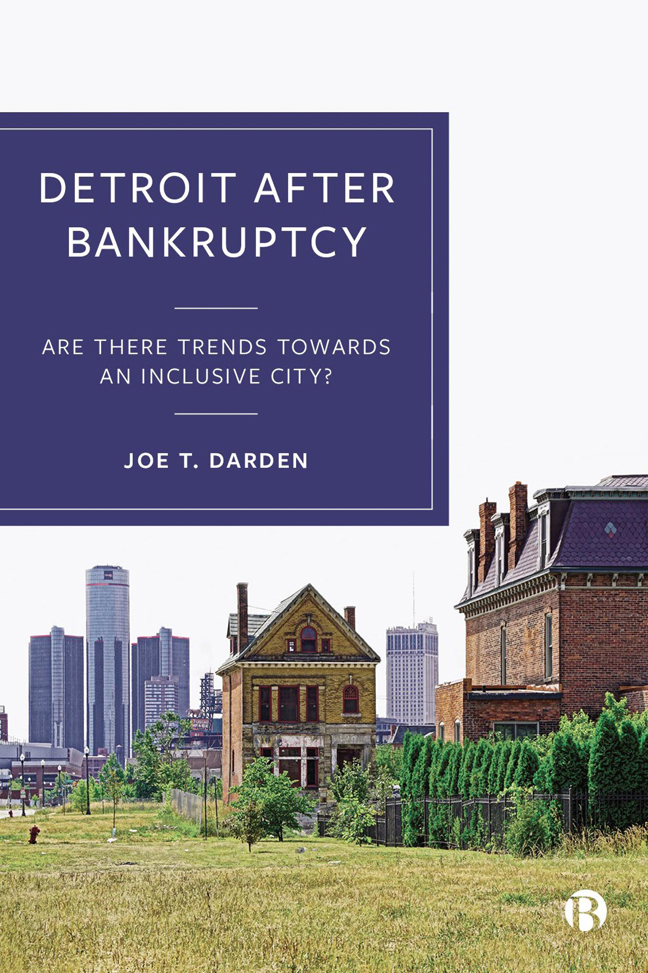Book contents
- Frontmatter
- Dedication
- Contents
- List of Figures and Tables
- Acknowledgments
- Preface
- 1 Antecedents to Bankruptcy
- 2 Detroit Bankruptcy: The Characteristics of the Decision Makers and the Differential Benefits Afterwards
- 3 The Postbankruptcy Social and Spatial Structure of Metropolitan Detroit: Anatomy of Class and Racial Residential Segregation
- 4 Gentrification: A New Method to Measure Where the Process Is Occurring by Neighborhood
- 5 The Uneven Distribution of Economic Redevelopment: Which Neighborhoods Are Excluded?
- 6 Black and Hispanic Underrepresentation in Business Ownership in a Majority-Black City
- 7 Racial Inequality in Student Academic Achievement Levels: A Neighborhood Solution to the Problem
- 8 Unequal Exposure to Crime in the City of Detroit: A New Method to Measure Exposure by the Characteristics of Neighborhoods
- 9 Solving the Problem of Extreme Race and Class Inequality: Implementing the Spatial Mobility Alternative
- 10 Conclusions: The Status of the Residents of Detroit after Bankruptcy
- References
- Index
7 - Racial Inequality in Student Academic Achievement Levels: A Neighborhood Solution to the Problem
Published online by Cambridge University Press: 25 January 2024
- Frontmatter
- Dedication
- Contents
- List of Figures and Tables
- Acknowledgments
- Preface
- 1 Antecedents to Bankruptcy
- 2 Detroit Bankruptcy: The Characteristics of the Decision Makers and the Differential Benefits Afterwards
- 3 The Postbankruptcy Social and Spatial Structure of Metropolitan Detroit: Anatomy of Class and Racial Residential Segregation
- 4 Gentrification: A New Method to Measure Where the Process Is Occurring by Neighborhood
- 5 The Uneven Distribution of Economic Redevelopment: Which Neighborhoods Are Excluded?
- 6 Black and Hispanic Underrepresentation in Business Ownership in a Majority-Black City
- 7 Racial Inequality in Student Academic Achievement Levels: A Neighborhood Solution to the Problem
- 8 Unequal Exposure to Crime in the City of Detroit: A New Method to Measure Exposure by the Characteristics of Neighborhoods
- 9 Solving the Problem of Extreme Race and Class Inequality: Implementing the Spatial Mobility Alternative
- 10 Conclusions: The Status of the Residents of Detroit after Bankruptcy
- References
- Index
Summary
Introduction
Since the City of Detroit came out of bankruptcy on December 11, 2014, a major question of many Black parents living in the city—where their children must attend schools—is whether their children, who are attending racially segregated schools, are receiving an equal education to white students living in Wayne County (outside of the city), Macomb County, and Oakland County. The objective of this chapter is to answer this question using the most appropriate data and methods. Much data were obtained from the Educational Opportunity Project at Stanford University (Reardon et al, 2022). The researcher there used public school test scores in grades 3–8 from 2008–9 through 2017–18 to create the first comprehensive database on educational opportunity in the US. For this chapter, the data used from the Stanford project database focus on overall average district test scores for Black, white, and Hispanic students. Student scores are compared to the national average test scores.
Calculating the national average test scores
The Educational Opportunity Project first calculated the mean test score in each school, district, county, metropolitan statistical area, commuting zone, and State for all students and by student subgroups (gender, race/ethnicity, and economic disadvantage). Low test scores indicated low educational opportunity and high test scores indicated high educational opportunity. The Educational Opportunity Project data also revealed learning rates, which explore how much students learn each year, to see how the nation's schools are contributing to educational opportunity and trends in test scores. In turn, these scores revealed how much average test scores are changing each year and provided an insight into where educational opportunities are improving or declining. The following section indicates overall average test scores, test scores for Black, white, and Hispanic students for a racial comparison, and poor and nonpoor students for a class comparison for Detroit and selected suburban school districts. I begin with the Detroit public schools community district.
Detroit public schools community district
Overall average test scores: –2.68
Black students: –2.76; white students: –2.51; Hispanic students: –2.31; poor students: –2.78; nonpoor students: –1.98
Educational opportunity overview
Based on the data that compare all districts in the US, the Educational Opportunity Project concluded that the Detroit school district is a district where test scores are lower than the US average and test scores have been declining over time.
- Type
- Chapter
- Information
- Detroit after BankruptcyAre There Trends towards an Inclusive City?, pp. 117 - 144Publisher: Bristol University PressPrint publication year: 2023



